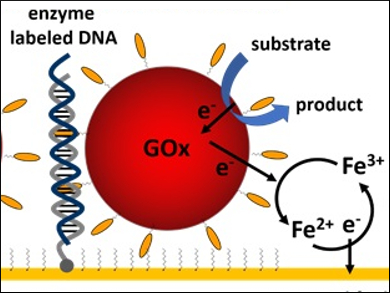DNA detection and DNA chips are becoming important in medical diagnostics. The covalent labeling of the target DNA, usually with dyes or enzymes, significantly enhances the sensitivity of DNA detection at the expense of simplicity and sample preparation. Alternative label-free detection methods based on electrochemical hybridization have advantages such as ease of miniaturization, inexpensive device fabrication, operational simplicity, and rapid detection.
Label-free DNA detection based on intercalation is of high interest since here the detection process is largely independent of the target DNA sequence. When the intercalating species is tethered to a redox enzyme, sensitive electrochemical detection is possible because the biocatalyst can be electrochemically addressed by a redox probe. The latter is continuously recycled at an electrode during catalysis. This consequently leads to a signal amplification of the measured current.
Wolfgang Schuhmann, Ruhr-Universität Bochum, Germany, and colleagues have designed a DNA label based on glucose oxidase (Gox, biocatalyst) that was covalently modified with an acridine orange (AO) derivative as the intercalating species. A discrimination between single-stranded DNA (ssDNA) and double-stranded DNA (dsDNA) was possible due to the preferred intercalation of the synthesized AO–enzyme conjugate into the dsDNA.
This concept provides a simple and sequence-independent detection label for DNA analysis. It may be coupled with other amplification strategies to develop highly sensitive DNA sensors.
- Amperometric Detection of dsDNA Using an Acridine-Orange-Modified Glucose Oxidase,
Daliborka Jambrec, Klaus Lammers, Tim Bobrowski, Sascha Pöller, Wolfgang Schuhmann, Adrian Ruff,
ChemPlusChem 2017.
DOI: 10.1002/cplu.201700279


